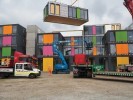The need for more social housing in the UK is a fact that can’t be argued against, but how can this be addressed? Chris Slezakowski, Innovation Director for the UK & Ireland at SIG, looks at the benefits that alternative construction methods can bring to the table.
As stated in a recent press release by housing and homelessness charity, Shelter, the loss of private tenancy is the single biggest cause of homelessness, with eviction from private tenancies accounting for 78% of the rise in homelessness since 2011.




The seriousness of this issue has also been recognised by the Government, with its support for The Homelessness Reduction Private Members Bill being announced in October 2016, a week after it was confirmed that £40m would be provided for innovative approaches to tackling and preventing homelessness.
To further address the issue of housing availability, and the methods by which more homes could be constructed, the Government released its Housing White Paper, titled 'Fixing Our Broken Housing Market' in February 2017. In her foreword to the paper, the Prime Minister, Theresa May, states “…because building the homes we need will take time, we will also take more steps to continue helping people now, including improving safeguards in the private rented sector, and doing more to prevent homelessness and to help households currently priced out of the market”.
So, what are these steps? A number of suggestions are made in the White Paper, including the relaxing of the planning process and a greater use of public and brownfield land for housing, as well as highlighting when individuals or organisations are buying land that is suitable for housing but not building on it.
In addition to procedural changes, the White Paper considers different construction methods as a means of building homes more quickly, including the benefits of modular and factory-built homes, stating:
“Industry reports suggest homes constructed off-site can be built up to 30% more quickly than traditional methods, and with a potential 25% reduction in costs. They are high quality, reliable, more productive and can be highly energy-efficient.” One additional advantage of modular building is that, unlike some traditional methods, it lends itself well to direct commissioning, allowing the Government or local authorities to work directly with manufacturers, such as SIG Offsite, to create housing. This allows the client to order exactly what they and their community needs, rather than selling the land in the hopes that the planning system delivers what is needed.
A recent example of this approach is SIG Offsite’s involvement in the ‘PLACE/Ladywell’ scheme. Working directly with Lewisham Council and the project’s architect firm Rogers Stirk Harbour + Partners, SIG Offsite was tasked with creating an energy-efficient residential development for 29 families, plus community spaces at ground level.
Perhaps the most unique requirement was that the development had to be built in such a way that it could be transported to other locations, allowing urgent housing needs to be met in the area while permanent homes were created. The units can then be transported elsewhere to meet demand, and the process repeated.
Though the modular nature of off-site construction was ideal in this instance, and can certainly meet these particular challenges, the construction industry (and the UK as a whole) would be better served by off-site construction as a supplementary build method, rather than a replacement for traditional techniques.
I am not suggesting setting down tools and moving to an entirely modular construction method, as even fewer homes would be created that way. Instead, builders can carry on using their current skills, and add capacity through the use of off-site construction, rather than putting more pressure on already stretched skilled tradespeople.
This also means that contractors, developers and the supply chain can avoid having to invest heavily in training and materials. Instead, existing tradespeople can work alongside those specialist off-site firms which already have the relevant experience. Indeed, some modular component manufacturers, including SIG Offsite, are addressing the shortage of appropriately skilled workers, training not only their in-house staff, but also site-based personnel. This ensures that the units are not only made to the highest possible standards, but that they are also installed correctly, removing the risk of contractor errors affecting performance.
Working in this way will provide the best of both worlds, with the consistently high quality of factory-produced units and the problem-solving abilities of experienced tradespeople on site ensuring that news homes are not only built more quickly, but to the highest possible standard.
Using more off-site manufacturing can also offer other benefits. By removing the need to have raw materials on site, traffic can be reduced, with just one vehicle needed to transport one complete unit where many would have transported its component parts. This not only cuts carbon emissions, but also improves project efficiency, especially in densely populated urban areas where congestion is a significant problem.
This change towards modular building is already beginning to take place, with factory-made units ranging from floor cassettes to entire rooms complete with plumbing and fixtures being used in residential projects, however the industry needs to do more to explore modern methods of construction.
After all, there’s no sense in continuing to use the same methods and expecting different results.









